MARIANI’S
November 30, 2008
NEWSLETTER
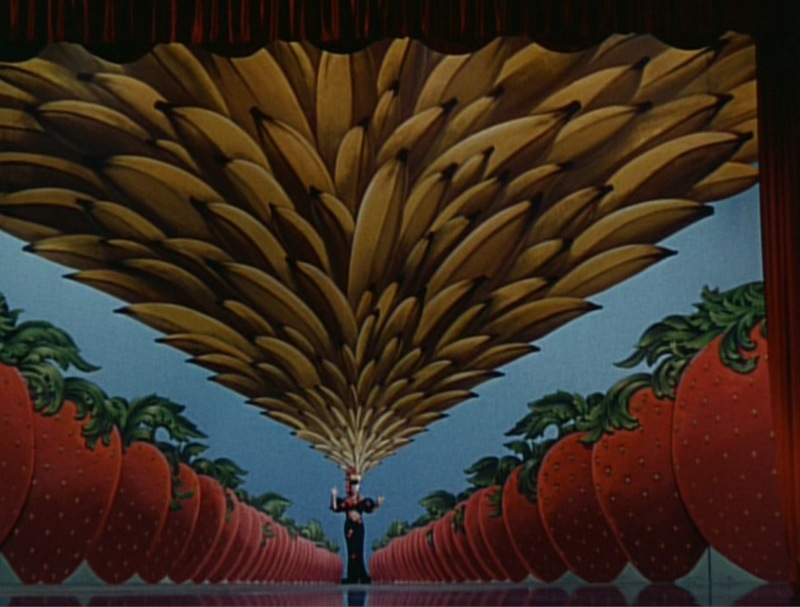
Carmen Miranda, "The Girl in the Tutti Frutti Hat" from
"The Gang's All Here" (1943)
NEW! Click esquire.com
to go to my new column at Esquire
Magazine.
ARCHIVE: Readers may now access
an
Archive of all past newsletters--each annotated--dating back to July,
2003, by simply clicking on www.johnmariani.com/archive
SUBSCRIBE AND
UN-SUBSCRIBE: You may subscribe anyone you wish
to this newsletter--free of charge--by
clicking here.
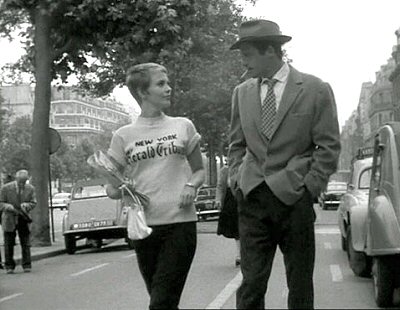
SEMI-IMPORTANT ANNOUNCEMENT: Next week's issue (Dec. 7) of Mariani's
Virtual Gourmet will arrive one day late, on Dec.8, because
Mariani will be in Paris next weekend.
~~~~~~~~~~~~~~~~~~~~~~~~~~~
In
This Issue
NEW YORK CORNER: CORTON by John Mariani
NOTES FROM THE WINE CELLAR: ORGANIC WINES? AREN’T THEY ALL? by John Mariani
QUICK BYTES
~~~~~~~~~~~~~~~~~~~~~~~~
In Boston You Can Eat in Prison or Have a Cow
by John Mariani
It’s
been a long time since Boston was called “the
land of the bean and the cod.” Cod is a rarity on menus and Boston
baked beans almost impossible to find, save at the venerable
Durgin-Park Café, opened in 1827. Boston restaurants are now as
diverse as anywhere else in America, and this year three of the new
hotspots reflect novel turns on old ideas while not entirely forsaking
New England culinary traditions.
SCAMPO
The
Liberty Hotel
215
Charles Street
857-241-1150
www.scampoboston.com
Scampo
is set in the exciting new Liberty
Hotel, reclaimed from an 1851 granite prison closed in 1973 after
being
declared unfit for inmates to live in. Now, the former slammer
encloses one of the finest high-end hotels in the city, with grand
panoramas over Boston and Cambridge. There’s a bar here called The
Clink, but they don’t push the prison gimmick too far.
Scampo is downstairs, with some of the
original prison bars intact, a casual, brick-walled Italian restaurant
with horseshoe bar decked out with ESPN screens. The chairs are soft
leather
and tables are admirably well set with linens and good stemware. A big
open kitchen
with an eating counter features a menu of small and large plates, and
it’s quite a departure from the typical Italian-American fare served in
Boston’s Little Italy neighborhood in the North
End. 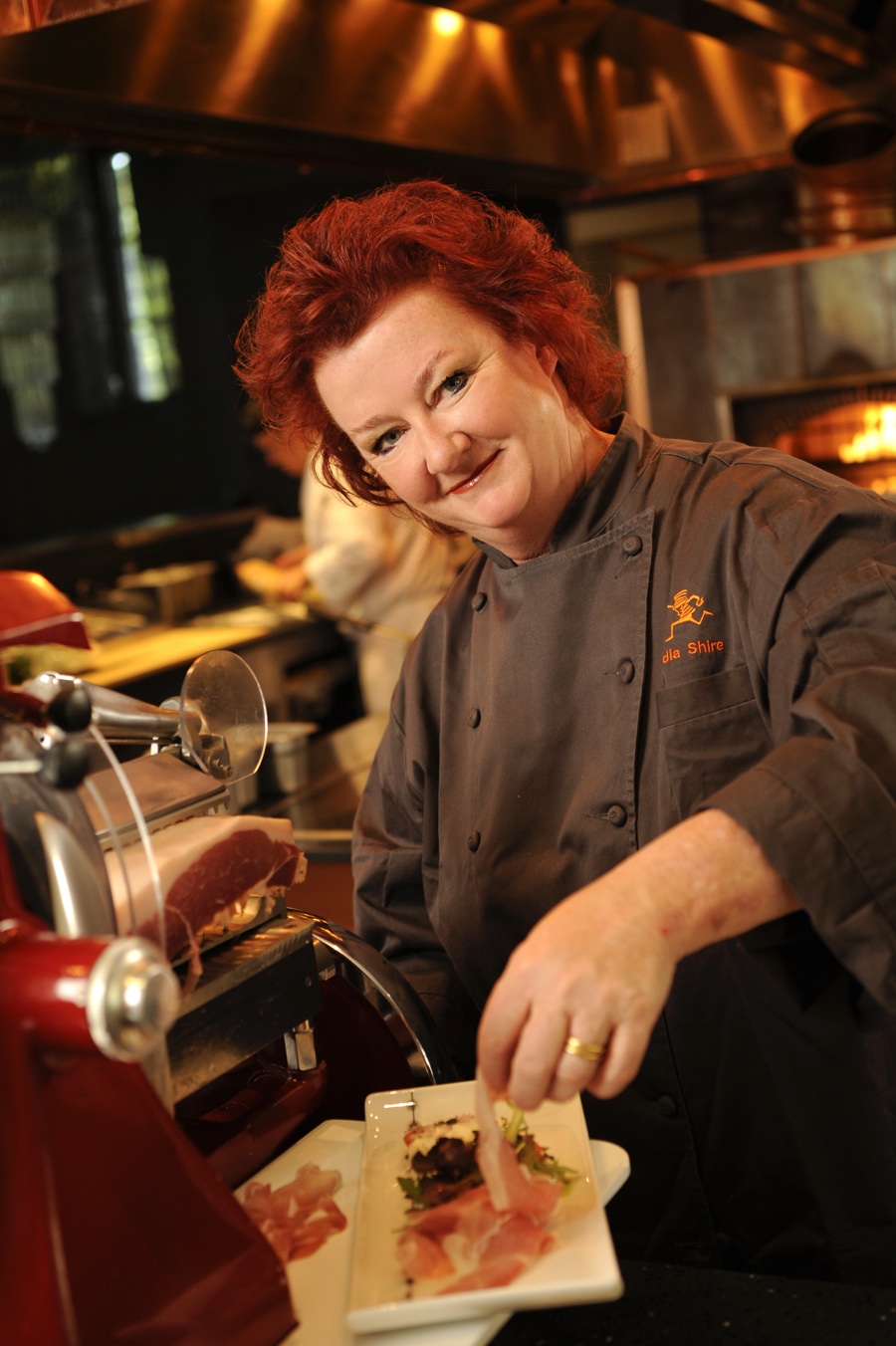 Chef-partner
is Lydia Shire (below), one of
the
pioneers of “New New England
Cuisine” in the 1980s, and, since 2001,
owner of the historic Brahmin dining room Locke-Ober Café. At
Scampo she is encouraging guests to eat any way they wish—a plate of
cheese and breads, some pizza, pastas, or hefty, generous main courses.
It's all meant to be fun: Ask for waiter Mario Di Pasquale, whose crazy
exuberance sets exactly
the right tone for a night at Scampo.
Chef-partner
is Lydia Shire (below), one of
the
pioneers of “New New England
Cuisine” in the 1980s, and, since 2001,
owner of the historic Brahmin dining room Locke-Ober Café. At
Scampo she is encouraging guests to eat any way they wish—a plate of
cheese and breads, some pizza, pastas, or hefty, generous main courses.
It's all meant to be fun: Ask for waiter Mario Di Pasquale, whose crazy
exuberance sets exactly
the right tone for a night at Scampo.
Out
of an Indian tandoori oven comes
smoky, blistered focaccia
bread with wine grapes and coarse sugar.
Roasted garlic and anchovies top a sizzling thin-crust pizza. Fat sea
scallops are roasted and served on white eggplant puree, and there are
wonderful pastas like ricotta-stuffed cappellacci
graced with walnut
brown butter. Hazelnut risotto is pumped up with sweetbreads and a shot
of sherry-like vin santo.
For main courses there is thickly sliced Prime
steak, and lobster with fennel and spiced lemon oil. On Fridays people
pile in for her “suckling pig al
forno”–leg, chop, and shoulder, all
with crackling crisp skin and a side of corn, mushrooms, and bacon.
For dessert, go with the ricotta cheesecake
with almond toffee and mango sorbet, or a plate of freshly baked
cookies with espresso and a tot of grappa.
The winelist is solid and reasonably
priced, somewhat more global than Italian.
Scampo is open for lunch and dinner daily. Dinner appetizers $5-$18, main
courses $12-$49.
Mooo
XV Beacon
Hotel
15 Beacon
Street
617-670-2515
www.mooorestaurant.com.
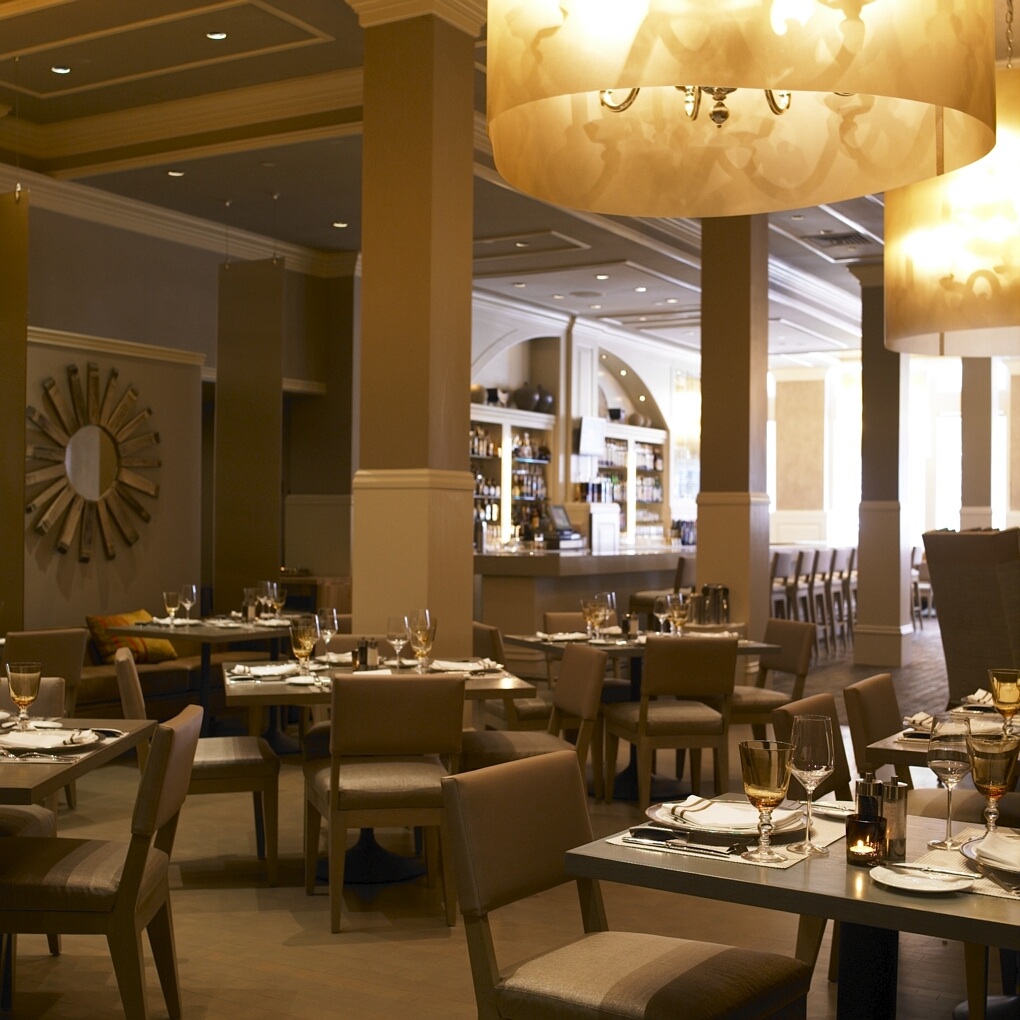 Before
Mooo was Mooo it was a more
formal, very pricey New England restaurant named The Federalist within XV Beacon, which,
since opening in 2000, has developed into Boston's finest, most refined
small hotel. Last summer the restaurant was taken over by chef Jamie
Mammano, who
also runs the
popular Mediterranean restaurants Mistral and Sorellina. Mooo's
pillared
dining room looks much the same, but the menu, under exec chef David
Hutton, now revolves around
steaks and chops, with a few New England items for good measure.
Before
Mooo was Mooo it was a more
formal, very pricey New England restaurant named The Federalist within XV Beacon, which,
since opening in 2000, has developed into Boston's finest, most refined
small hotel. Last summer the restaurant was taken over by chef Jamie
Mammano, who
also runs the
popular Mediterranean restaurants Mistral and Sorellina. Mooo's
pillared
dining room looks much the same, but the menu, under exec chef David
Hutton, now revolves around
steaks and chops, with a few New England items for good measure.
Indeed, I urge you to have the lobster bisque,
as creamy and full of lobster flavor as any I’ve ever tasted,
convincingly laced with sherry and cognac. The humble lobster roll is
terrific here, with a generous amount of meat in a rich, well-spiced
mayonnaise. The accompanying clam chowder, on the other hand, was dark,
cloyingly thick, and the flavor of the clams got lost in the smokiness
of bacon. Kobe dumplings—not what I’d expected in a Boston
steakhouse--were delicious, sauced with soy, ginger and scallions, and
not a bad price at $14.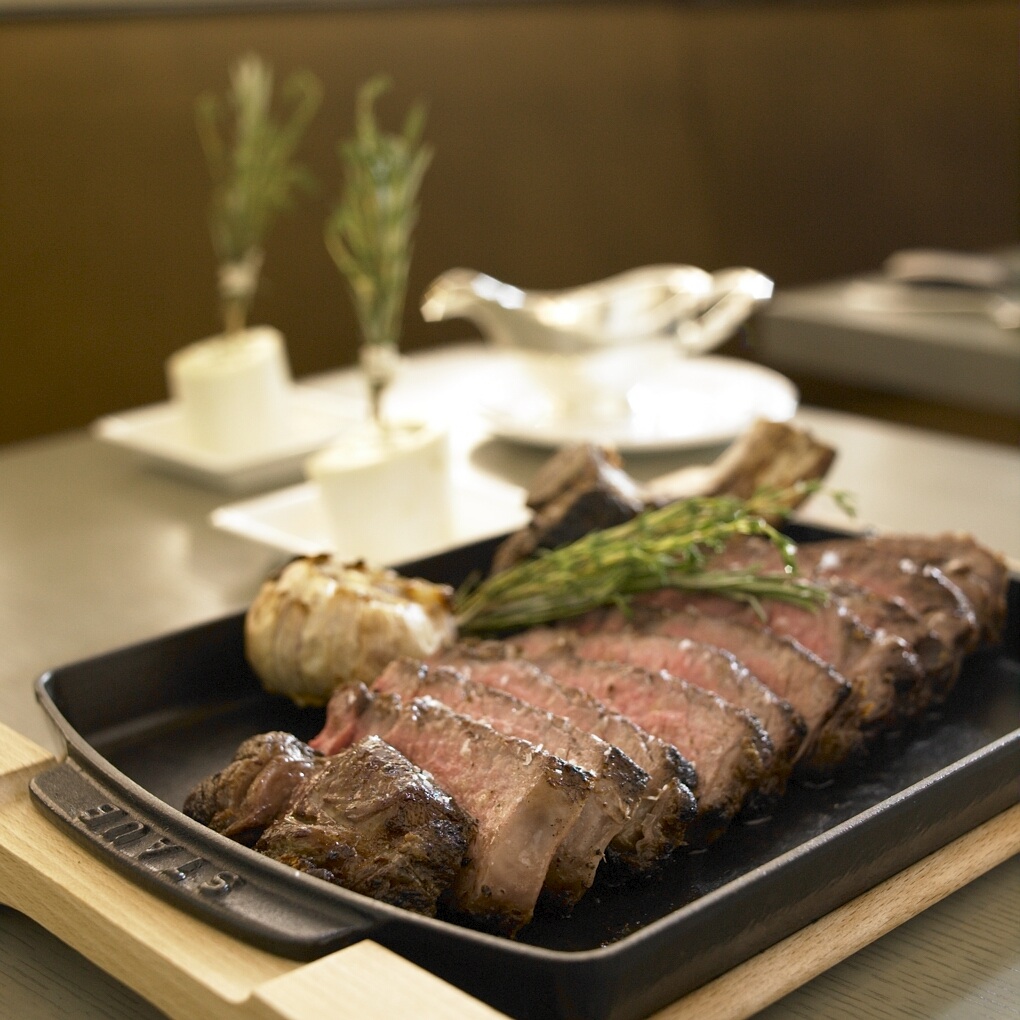
There was a heavy hand with the salt the
last time I dined at Mooo, which compromised beer-battered fish and
chips, as well as some otherwise addictive truffled and parmesan-dusted
French fries. And I’m not sure why they bother to put Wiener Schnitzel
with egg and capers on the menu here at all. Mooo’s version is
nothing special.
Mooo’s name, of course, demands you have
its beef, and you won’t be disappointed with the quality. I much prefer
the 14-ounce Prime New York sirloin to the “Painted Hills New York
Sirloin,” which is fed mainly on grass then finished with corn, lacking
that fat marbling, minerality, and richer flavor of the Prime sirloin.
Apple crumb tart makes for an excellent
autumn dessert here, and while the taste of the homey gingerbread with
caramel sauce and vanilla ice cream was almost Christmas-y, it would
have been better served warm.
Mooo’s winelist is a tremendous screed
of rare Bordeaux and California cabernets, built up over years when
expense accounts were fat and liberal. Carved out of a 1722 mansion,
with double vaulted ceiling, it seats 36 guests. Now, however,
the list needs a major
overhaul for leaner wallets: Of 18 American chardonnays listed only two
are under $50. And of 24 American pinot noirs, not a single bottle
under $50. Ask for the ebullient wine director Sarah
DiBari to help you
out, and she'll find something first rate within your budget.
Mooo is open for breakfast,
lunch, and dinner daily. Dinner appetizers $12-$68,
main courses $24-$120.
L'ANDANA
86
Cambridge Street
Burlington,
Massachusetts
781-270-0100
www.landanagrill.com
Burlington,
Massachusetts, is not very far outside of Boston, and if you've got
wheels, L'Andana is well worth the drive. It's in a suburban mall, in a
former golf shop, which is not the best advertisement for a fine
restaurant. This, like Mooo, is another Jamie Mammano production, with
the kitchen turning out some authoritative "wood-grilled" Tuscan
cuisine in a very attractive setting of weathered barn wood, burnished
metal, Italian mosaics, and bronze-shaded chandeliers made from old
wine barrels--a mix of rusticity and modernity that works seamlessly,
despite its capacity for seating 240 people, with 30 more seats in the
lounge, and the inevitable party room. Such size always concerns me
about consistency, for when I dined at L'Andana, it was a fairly quiet
time. Also,
looking over press releases and local reviews, it seems the exec chef
has changed at least three times.So, dear reader,
if you go on a busy night do let me know how they handle the pressure.
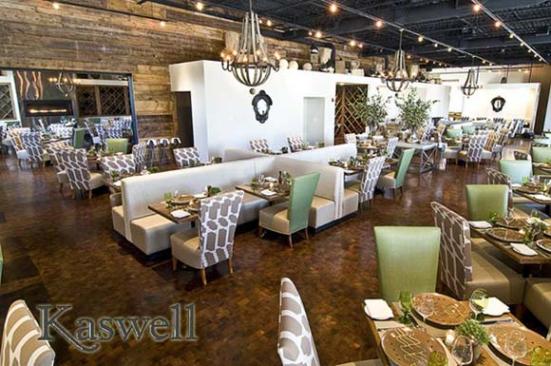 That said,
the conceptions here are wonderful, beginning with some good Italian
soups like mushroom with parmesan cream. Other primi I enjoyed were a wood-grilled
artichoke with an assertive lemon aioli, parsley, and capers, and a
superbly tender and flavorful grilled octopus with potato, soppressata,
pickled onions, and a chile bite. An assemblage of
seafood--shrimps, scallops, and lump crabmeat--with cucumber and lemon
dressing came deliberately cold, when it should have been room
temperature, and it was thereby robbed of some flavor.
That said,
the conceptions here are wonderful, beginning with some good Italian
soups like mushroom with parmesan cream. Other primi I enjoyed were a wood-grilled
artichoke with an assertive lemon aioli, parsley, and capers, and a
superbly tender and flavorful grilled octopus with potato, soppressata,
pickled onions, and a chile bite. An assemblage of
seafood--shrimps, scallops, and lump crabmeat--with cucumber and lemon
dressing came deliberately cold, when it should have been room
temperature, and it was thereby robbed of some flavor.
For some reason L'Andana places
the pastas to the right of the meats. I doubt it's because the kitchen
considers them afterthoughts, but I wasn't thrilled with rigatoni in a
bland bolognese or the spaghetti alla
chitarra with shrimp, guanciale
bacon,
chilies, and a tomato broth--a dish that should have soared but was
mundane. Excellent indeed, however, was tortellini with lobster,
onion and olive oil and a tarragon cream in which all the tastes and
textures melded well.
Still,
as at Mooo, the meats are clearly the
focus here, and I thought the
ribeye, juicy and fatty, was impeccable, and swordfish--a tricky
creature to keep fresh and cook well--was succulent and gained much
from peppers, onions, cured tomato, olive, and capers--a dish that was
not all that Tuscan but was better than any seafood I've had in that
region. But the very best dish I had was a superlative
duck--marvelously flavorful, with a vegetable barley risotto and the
tang and sweetness of a spiced orange glaze.
Every dessert was
distinguished, from a crostada
with lime cream, sautéed pineapple, and
coconut sorbet to an Italian version of baked Alaska with vanilla and
hazelnut chocolate semifreddo
and Amarena cherries.
The winelist is some 200
selections strong, mostly Italian, with dozens by the glass (from
$8-$18), as many half-bottles, including Champagne, and then pages of
bottles with plenty selling for under $50, which is a far cry from the
list at Mooo.
If you're anywhere near Burlington,
then, L'Andana would be an ideal choice for fine Italian food. I only
wish it were smack in Beantown itself.
L'Andana is open for dinner nightly.
Antipasti run $8-$15, full portions of pasta $19-$25 as entrees, main
courses $22-$44.
~~~~~~~~~~~~~~~~~~~~~~~~~~~~~~
NEW
YORK CORNER
by John Mariani
CORTON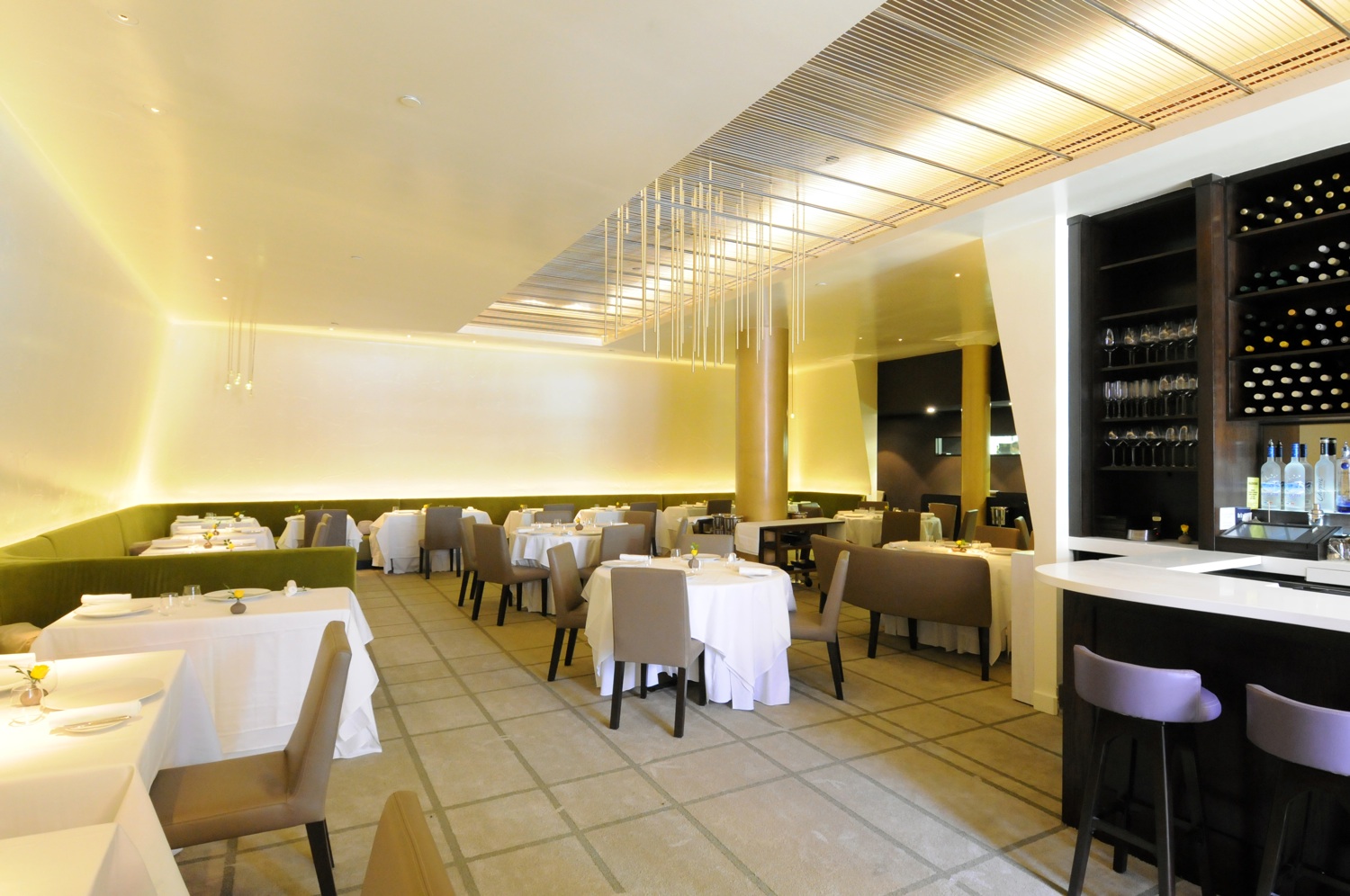
239 West Broadway (near
White Street)
212-219-2777
www.cortonnyc.com
The
closing two years ago of one of New York's seminal restaurants of the
late 1980s, Montrachet, quite possibly foretold the shift in
dining out that occurred as the economy slowed down. Montrachet
was opened on a shoestring--and a loan from his mother--by Drew
Nieporent, whose gamble in locating down in TriBeCa, when there were
very
few restaurants of any kind there, paid off overnight when the New
York Times awarded it three stars.
Chefs came and went as
Nieporent
expanded his holdings through his Myriad Restaurant Group to include
Nobu and several of its branches, while a certain movie star glamor
attached itself to several of the enterprises, since people like Robert
DeNiro and Robin Williams were partners in some of them, so the
restaurants were a draw for that, as well as culinary reasons. But
Montrachet's time in the sun had faded in the last few years,
especially since TriBeCa, which it helped jump start as a restaurant
destination, become overgrown with new entries, most more casual.
The fact that
the economy started to collapse more than a year ago didn't help, and
Nieporent (who still has the admirable TriBeCa Grill, Nobu, Nobu Next
Door, Mai House, and Centrico in the neighborhood) let Montrachet's
premises lie fallow from 2006 until now. Its replacement is the
very
serenely cool Corton.
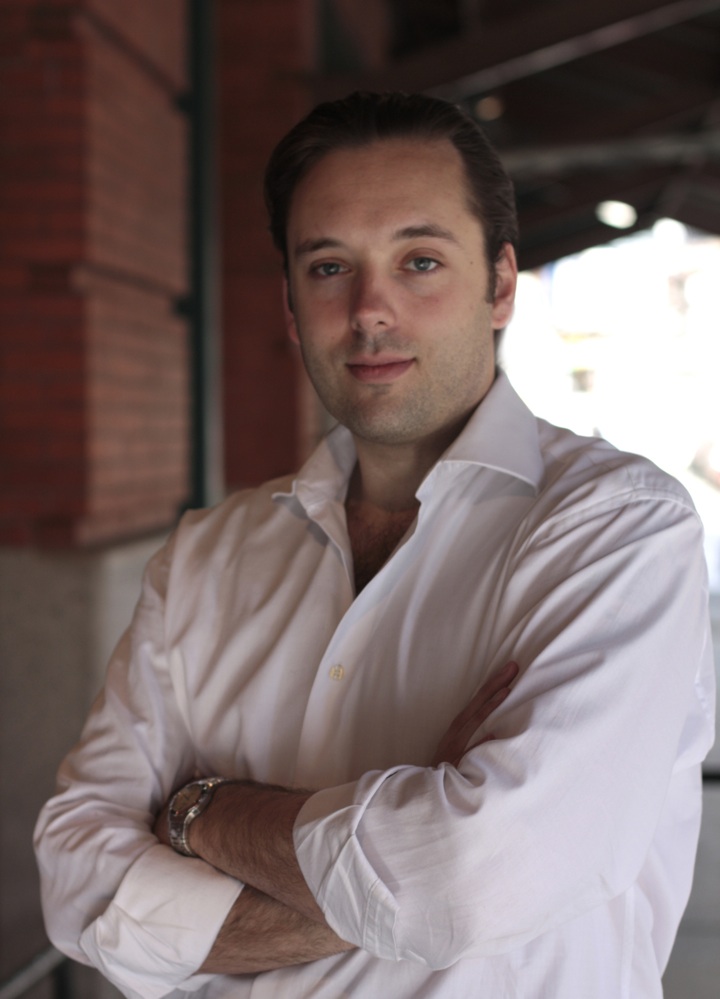 Where Montrachet was never highly
decorated, Corton is barely so, in a minimalist style of pale Champagne
color walls, widely separated tables, soft lighting, and white
tablecloths set with Riedel, Laguiole, and Christofle. I'd like to see
some color or artwork on those walls.
Where Montrachet was never highly
decorated, Corton is barely so, in a minimalist style of pale Champagne
color walls, widely separated tables, soft lighting, and white
tablecloths set with Riedel, Laguiole, and Christofle. I'd like to see
some color or artwork on those walls.
The chef is something of a surprise:
British-bred Paul
Liebrandt (left), whose
training at Pierre Gagnaire seemed to urge him on to carve out a
dubious reputation with extremely experimental,
idiosyncratic cuisine and service at other restaurants like Atlas and
Gilt; at another restaurant, he held
dinners in complete darkness. So I was puzzled as to why
Nieporent had taken him on at a restaurant that, like Montrachet,
seemed to evoke the refined traditions of Burgundy. Having now
dined at Corton, I see that Nieporent must have known that under the
veneer of eccentricity lay Liebrandt's considerable talents for a purer
cuisine.
Within days of opening Corton was
visited by some of New
York's finest chefs, all curious to see if Nieporent and Liebrandt were
divining the future of New York gastronomy.
I'm not sure anything quite so prescient
is going on at Corton; I do know that the cooking is of a very high
order with some engagingly novel ideas but not a whit of pretense
about the evening's proceedings. Indeed, Nieporent has always
been an exemplary host--part bon vivant, part partygiver, and full
professional. So he's likely to greet you and chat with you
throughout the evening, and is likely to know most of the people in
the room. Just as you sit down, out come hot gougères pastries
filled with Mornay sauce--a very lusciously good start indeed.
The remarkable thing to me about
dining
out several times a week, here and abroad, is how chefs keep coming up
with marvelous new ideas no others had before, and to do so without
getting showy about it (as many of Liebrandt's dishes once were).
At Corton he will make a lovely, classic velouté of Jerusalem
artichokes with crabmeat, but just by adding a little parmesan and
smoked pasta, makes it new and exciting. Simple and simply perfect baby
vegetables with fruits and herbs taste like the first salad of Eden,
while scallops take on a light brininess from the subtle use of sea
urchin cream, the crispness of radish and almonds, while caramelized
veal sweetbreads come with an oozing egg yolk "confit," carrot, and argan
oil--a superb dish. I'm not sure adding a layer of beet borscht
gelée
and blood orange to foie gras pushes the envelope any further than
others have.
Liebrandt, working out of a very small
kitchen, does brilliant work with seafood, where the subtleties of his
craft show the best in dishes like cobia with potato-eggplant terrine,
black olive, and something called "vadouvian spice," an Indian
mixture. Turbot, usually a very bland fish when served this side
of the Atlantic, took on some grace notes from having a spiced almond
crust, black garlic, and a citrus-coconut broth.
Meats work almost as well at
Corton, including a rolled squab with chestnut cream, smoked bacon and
foamy pain d'épices milk (I'd hoped foams had passed into
culinary
limbo by now), though a filet of beef with beets, oxtail, and fondant
potato was good if ho-hum.
For dessert, Robert
Truitt's gianduja "palette"
gives you a heavenly trio of chocolate,
hazelnut, and tangy yuzu in profusion.
Corton's winelist of
course offers many wines of Corton, at very price levels, and I commend
Nieporent for carrying about three dozen good country wines under $50.
In this economy, that is where the sweet spot is.
The local
reviews for Corton thus far have been raves, and I can see that the
restaurant will evolve into one of the city's very finest. My
compliments to Drew Nieporent for his persistence in believing in fine
dining and to Liebrandt for finding where his true talents lie.
Corton is open for dinner Mon.-Sat. Fixed price 3-course menu at $76, and $110 for eight.
~~~~~~~~~~~~~~~~~~~~~~~~~~~~~~~~~~~~~
NOTES
FROM THE WINE CELLAR
ORGANIC
WINES? AREN'T THEY ALL?
By John Mariani
What’s
in a name? Organic.
Natural. Sustainable. Slow. And when it comes to wine, what do any of
the those terms have to do with a grape-based beverage we have been
happily and healthily drinking for millennia?
Only the term “organic” really has any meaning
when it comes to contemporary wines, although it would appear that
wines have always been organic in the dictionary sense of being part of
“a class of chemical compounds that formerly comprised only those
existing in or derived from plants or animals, but that now includes
other compounds of carbon.” That would certainly include grapes.
Nevertheless the science of viticulture (grape
growing) and viniculture (winemaking) has over centuries improved the
chances of making better wine by using everything from natural compost,
which enriches the soil, to sulfur, which prevents bacterial spoilage.
Merely using the word “organic” does not mean allowing nature simply to
take its course, along with a few Hail Marys to help things along.
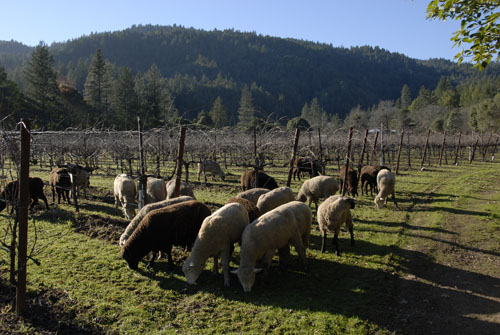 In
Europe, the EU’s legal definition of
organic does not even cover the production of wine; it only states that
the wine must be made from organically grown grapes. In the U.S.
and Australia, that definition is expanded to include “organic wine,”
made without the addition of sulfur dioxide. Less than one percent of
American and Australian wines are thus labeled.
In
Europe, the EU’s legal definition of
organic does not even cover the production of wine; it only states that
the wine must be made from organically grown grapes. In the U.S.
and Australia, that definition is expanded to include “organic wine,”
made without the addition of sulfur dioxide. Less than one percent of
American and Australian wines are thus labeled.
A few other standards are set solely
within small viticultural areas, not federally or by the staters.
Certain forms of filtration and cleaning agents are also discouraged. I
don’t even want to get into so-called “biodynamic” winemaking, which
tries to put vineyards in tune with astrology and “moods” when the
universe is in or out of harmony with vineyards. Whatever.
One can legitimately argue that the organic or
natural way of growing grapes and making wine makes the most sense, but
for the time being only small areas can afford to do so.
Alsace, Germany, and some South American vineyards are increasing their
organic output, but winemaking is so dependent upon the vagaries of
nature that organic farming can be very expensive and extremely
risky. The greater quantity of grapes required, as in Champagne,
the more un-natural safeguards vintners have to take, which even mean
simple irrigation (forbidden in some vineyards).
The first winery to claim organic status, back
in 1980, was Four Chimneys on Seneca Lake, New York, which makes a
great number of semi-sweet and sweet fruit wines from blackberries and
blueberries as well as from grapes. The San Francisco-based
Organic Wine Company imports its bottlings from the South of France;
its motto is “Where drinking good wine is a no-headache
decision!”—contending that, “Everybody should know by now that
AUTHENTIC wines made with UNSPOILED grapes do not produce such ill
effects. It's not their stomach that is in question but the
PRODUCT!” Those capitalized words—theirs, not mine—have no legal
meaning whatsoever.
Yorkville
Cellars in Mendocino makes
Bordeaux varietals like sauvignon blanc, semillon, cabernet franc, and
merlot. Frey Vineyards in Redwood Valley (above) has won awards for its
organic
wines and usually sells out its entire production each year. One of
California’s most committed organic wineries is Fetzer, whose mission
statement is, “Since 1984, we have pursued sustainable practices and
have always sought to expand and improve them. We don’t adhere to our
environmental commitment because it’s trendy or to make a political
statement. We do it because we believe that it results in better wines
and, quite simply, because it is the right thing to do.”
There is in all this always a whiff of smug
moralism in tune with saving the whales and the chipmunks in the oceans
and woodlands of the world—all admirable pursuits. But in a world
where increasing food production is paramount at the same time, while
there is an enormous surplus of wine, the importance of balancing
priorities may trump the dubious value of drinking a wine made
according to varying standards only recently applied in thousands of
different territories.
Simply saying your wine is organic does not
guarantee quality by a long shot; nor do most people have to give any
thought whatsoever to the possibility that the preservative sulfur
dioxide may cause a few people headaches. Only a fraction of one
percent of winemakers do not use sulfur dioxide, and, as the Oxford
Companion to Wine notes, “There have been attempts to produce
wines
without any addition of sulfur dioxide. Such wines are particularly
prone to oxidation and the off-flavours generated by wild yeast and
bacteria.” In any case, a small amount of the compound occurs
naturally as a by-product of fermentation, making it impossible to make
a wine completely free of sulfur dioxide.
So it gets back to the word: does “organic”
mean enough in the production of wine to make you seek such wines out?
It’s a choice, not a preference one can so easily indulge, and with
better care of healthier vineyards, wines labeled “organic” haven’t yet
proved much of anything.
~~~~~~~~~~~~~~~~~~~~~~~~~~~~~~~~~~~~~~~~~
THAT WAS NOTHING FOR JIM MORRISON!

In Providence, Rhode Island, State police arrested Stanley Kobierowski after he drove into a highway message board on Interstate 95 and found his blood alcohol level was 0.491 percent - the highest ever recorded in Rhode Island for someone who wasn't dead. He was taken to a hospital, put in the detoxification unit, and sedated. The legal limit in Rhode Island is 0.08. A level of 0.30 is classified as stupor, 0.4 is comatose and 0.5 is considered fatal, according to the health department.
 WORST
NEW ACRONYM OF 2008
WORST
NEW ACRONYM OF 2008
(SO
FAR)
“As a result, we've witnessed the exponential growth of
what we call Better Alternative to Home (BATH) restaurants -- casual,
modestly priced eateries (pasta-rias, burger joints, BBQs, upscale
diners, noodle shops and myriad ethnic places) as well as family dining
chains. These restaurants buy wholesale and produce meals far more
efficiently than home cooks.—Nina and Tim Zagat “People Still Have to
Eat,” The Wall Street Journal
(10/30/08). . . . MEANWHILE,
BACK IN XENIA, OHIO: A 25-year-old employee
of the
local
Burger King and aspiring musician thought fans would get a kick out of
watching him take a bath in the restaurant’s kitchen sink by making a
video on YouTube. The fast-food chain fired everyone who appeared in
the video.
QUICK BYTES
TO
ALL PUBLICISTS: Owing to the amount of
material sent to this newsletter regarding Christmas and
New Year's dinners--many of which are only announcements as to price
fixed dinners--it is impossible for me to include any but the most
unusual of events for those holidays in Quick Bytes.
--John
Mariani
*
From Dec. 1-14 Marquis
Los Cabos’ “Blue Cabo Culinary Getaway,” hosted by food and wine
expert Anthony Dias Blue celebrates Mexico’s prestige as a gastronomic
destination, as well as the food and wine landscape of Los Cabos, with
Chefs Thierry Dufour of Marquis Los Cabos; Margarita Salinas of San
Jose del Cabo’s Don Emiliano, and Dr. Jaime A. Villalobos Diaz,
founder of The Mexican Academy of Tequila-Mezcal-Wine Tasters. $1,485
pp. Visit www.marquisloscabos.com or call 877-238-9399.
* On Dec. 1 thousands of bars and taverns in NYC
will celebrate “Red Monday” for the 75th anniversary of the Bloody
Mary. NYS and local officials will proclaim Bloody Mary Day and honor Carol
Bradley, granddaughter of Ferdinand "Pete" Petiot, the Paris bartender
who brought the cocktail to NYC in the 1930s, with a citation and a
Bloody Mary toast. in the middle of Times Square at 1552
Broadway. A year-long celebration will take place thoughout the
USA with Bloody Mary themed events.
* For the entire month of December, bacar in San Francisco will
offer a special menu featuring Champagnes by-the-glass, half-glass and
in flights from producers incl. Perrier Jouet, Krug, Salon, Gaston
Chiquet and Rene Geoffery. Wine Director Haley Guild will guide guests
through these special selections, ranging from $18-$99, along with Chef
Morgan Mueller’s special menu, Call 415-904-4100; www.bacarsf.com.
* The 2008
Nevis International Culinary Heritage Exposition has been
rescheduled for Dec. 5-7,
celebrating top chefs from Nevis and the Caribbean with cooking
demos, seminars and gourmet showcases at Old Manor Hotel. Also, Walking
tour of Mansa’s Last Stop, Beach BBQ with martini and aged rum
tasting bars at Coco Beach; Veuve Clicquot champagne reception
and gala dinner with Hennessy cognac bar and cigar rolling at the
Nisbet Plantation Beach Club; Lunch by the Federation of St. Kitts
& Nevis Culinary Team. Those attending can purchase tix for
individual events or a complete package ($440 USD). Visit
www.nevis-niche.com or call 869-469-7550.
* On Dec. 7 in Berkeley, CA, Chocolatier Blue is hosting “A
Celebration of Chocolate: The First Annual Chocolatier Blue Chocolate
Festival.” $15 pp. Call 510- 805-8800; www.chocolatierblue.com.
* On Dec. 10 Ubuntu
restaurant in Napa, CA, will host a special evening in partnership with
Benziger family winery. Chef Jeremy Fox will serve a 5-course dinner at
$150 pp, with each course to highlight a different wine from the
Benziger winery. Call 707-251-5656.
* On Dec. 11, The Association for Community
Employment Programs for the Homeless (A.C.E.) and its neighborhood
initiative, the SoHo Partnership will host a SoHo Holiday Stroll with
participating venues stay open late, incl. restaurants and bars
Balthazar, Barolo, Centovini Restaurant, Lure, L'Orange Bleue and
Spring Lounge. Examples of Stroll promotions are 15% of your check and
live belly dancing at Moroccan hotspot L'Orange Bleue; Centovini
Restaurant is offering a 10% discount on its fare. Visit
www.sohoholidaystroll.com. Call 212- 274-0550 x17.
~~~~~~~~~~~~~~~~~
Everett Potter's Travel Report:

~~~~~~~~~~~~~~~~~~~~~~~~~~~~~~~~~~~~~~~~~~~~~~~~~~~~~~~~~~~~~~~~~~~~~~~~~~
Eating Las Vegas is the new on-line site for Virtual Gourmet contributor John A. Curtas., who since 1995 has been commenting on the Las Vegas food scene and reviewing restaurants for Nevada Public Radio. He is also the restaurant critic for KLAS TV, Channel 8 in Las Vegas, and his past reviews can be accessed at KNPR.org. Click on the logo below to go directly to his site.
~~~~~~~~~~~~~~~~~~~~~~~~~~~~~~~~~~~~~~~~~~~~~~~~~~~~~~~~~~~~~~~~~~~~~~~~~~~
Tennis Resorts Online: A Critical Guide to the World's Best Tennis Resorts and Tennis Camps, published by ROGER COX, who has spent more than two decades writing about tennis travel, including a 17-year stretch for Tennis magazine. He has also written for Arthur Frommer's Budget Travel, New York Magazine, Travel & Leisure, Esquire, Money, USTA Magazine, Men's Journal, and The Robb Report. He has authored two books-The World's Best Tennis Vacations (Stephen Greene Press/Viking Penguin, 1990) and The Best Places to Stay in the Rockies (Houghton Mifflin, 1992 & 1994), and the Melbourne (Australia) chapter to the Wall Street Journal Business Guide to Cities of the Pacific Rim (Fodor's Travel Guides, 1991). THIS WEEK: WINTER TENNIS BARGAINS

Family Travel
Forum: The
Family Travel Forum (FTF), whose motto is "Have Kids, Still Travel!",
is dedicated to the ideals, promotion and support of travel with
children. Founded by business professionals John Manton and Kyle
McCarthy with first class travel industry credentials and global family
travel experience, the independent, family-supported FTF will provide
its members with honest, unbiased information, informed advice and
practical tips; all designed to make traveling a rewarding, healthy,
safe, better value and hassle-free experience for adults and children
who journey together. Membership in FTF will lead you to new worlds of
adventure, fun and learning. Join the movement.
All You Need to Know Before You Go
~~~~~~~~~~~~~~~~~~~~~~~~~~~~~~~~~~~~~~~~~~~~~~~~~~~~~~~~~~~~~~~~~~~~~~~~~
MARIANI'S VIRTUAL GOURMET NEWSLETTER is published weekly. Editor/Publisher: John Mariani.
Contributing Writers: Robert Mariani,
John A. Curtas, Edward Brivio, Mort
Hochstein, Suzanne Wright, and Brian Freedman. Contributing
Photographers: Galina Stepanoff-Dargery, Bobby Pirillo. Technical
Advisor: Gerry McLoughlin.
Any of John Mariani's books below
may be ordered from amazon.com by clicking on the cover image.
 My
newest book, written with my brother Robert Mariani, is a memoir of our
years growing up in the My
newest book, written with my brother Robert Mariani, is a memoir of our
years growing up in the For those of you who don't think of the Robert and I think you'll enjoy this very personal look at our --John Mariani |
 |
 |
 |
 |
 |
 |
© copyright John Mariani 2008
